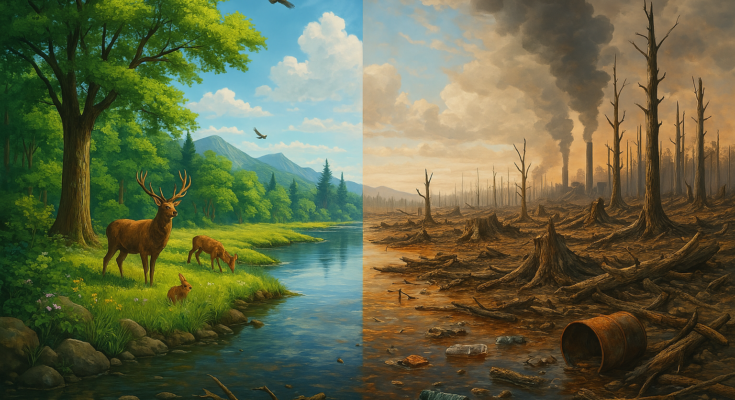The Natural Environment: Our Planet’s Lifeline and Legacy
The natural environment is Earth’s masterpiece—a delicate, interconnected web of air, water, soil, and life that sustains every living being. From the air we breathe to the forests that whisper secrets of biodiversity, these elements form the foundation of existence. Yet, this lifeline faces unprecedented challenges. Let’s explore its wonders, vulnerabilities, and the urgent steps needed to protect it.
What Makes Up the Natural Environment?
- Air: The invisible embrace of our atmosphere, rich with oxygen and carbon dioxide, fuels life itself. It’s the breath of forests and the engine of photosynthesis.
- Water: Covering 70% of Earth, it dances between oceans, rivers, and hidden groundwater reserves, quenching thirst and shaping landscapes.
- Soil: More than dirt—it’s a living, breathing ecosystem teeming with microbes, anchoring forests, and growing the food that feeds billions.
- Biodiversity: A symphony of plants, animals, and microorganisms, each playing a unique role in nature’s balance.
- Climate: The sun’s warmth, the rain’s rhythm, and the wind’s whisper—these forces orchestrate seasons and sustain habitats.
Why Does the Natural Environment Matter?
- Survival: It provides the essentials: clean air, fresh water, nourishing food, and raw materials for shelter and medicine.
- Biodiversity’s Refuge: From coral reefs to rainforests, it hosts millions of species, each a thread in the web of life.
- Climate Regulation: Forests act as Earth’s lungs, absorbing carbon, while oceans stabilize temperatures, shielding us from extreme weather.
- Inspiration and Wellness: Nature’s beauty reduces stress, sparks creativity, and drives eco-tourism, reminding us of our shared home.
Threats: The Human Footprint
Despite its resilience, the environment is under siege:
- Pollution: Industrial waste chokes rivers, plastic suffocates oceans, and smog clouds skies.
- Deforestation: Every minute, 30 football fields of forests vanish, displacing wildlife and accelerating climate change.
- Climate Crisis: Rising temperatures, fueled by fossil fuels, trigger wildfires, melting ice, and unpredictable weather.
- Overexploitation: Overfishing, poaching, and urban sprawl push species to extinction and disrupt ecosystems.
How Can We Protect Our Planet?
- Embrace Clean Energy: Shift to solar, wind, and hydropower to slash emissions and air pollution.
- Reduce, Reuse, Recycle: Cut waste by opting for reusable products and supporting circular economies.
- Rewild the Earth: Plant trees, restore wetlands, and create green spaces to revive habitats.
- Advocate and Educate: Spread awareness about sustainable living and hold industries accountable.
- Strengthen Policies: Demand stricter laws against pollution, deforestation, and illegal wildlife trade.
A Call to Action
The natural environment isn’t just a resource—it’s a legacy. Every forest saved, every river cleaned, and every species protected is a gift to future generations. The clock is ticking, but together, we can rewrite the story. Let’s choose conservation over consumption, and stewardship over shortsightedness. Our planet’s resilience depends on the choices we make today.



